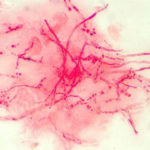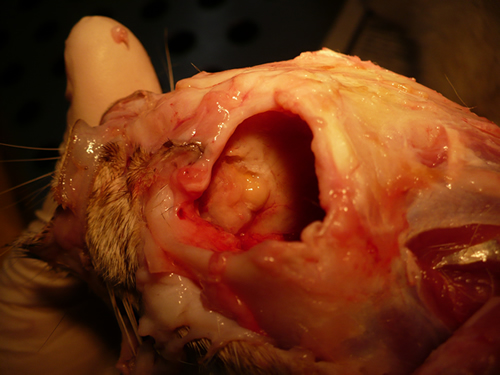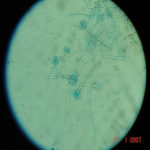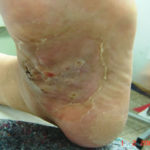Date: 26 November 2013
Nasal, sinus and orbital aspergillosis in a cat. The left nasal cavity and sinus were full of pus and debris and there was severe bone erosion from the nasal cavity into the rostromedial orbitthrough which pus was protruding
Copyright:
(Kindly provided by Martin L. Whitehead, BSc, PhD, BVSc, CertSAM, MRCVS & Peter W. Kettlewell, BVSc, MSc, MRCVS. Chipping Norton Veterinary Hospital, Albion Street, Chipping Norton, Oxon, OX7 5BN.)
Notes:
History : Nasal aspergillosis is relatively common in dogs but rare in cats. Our veterinary hospital in Oxfordshire was recently presented with a 13-year old female Burmilla cat with a history of left-side unilateral nasal discharge, a watery left eye with slight blepharospasm, occasional ‘twitching movements’ of the head, weight loss, inappetance and depression. Clinical examination was unremarkable except for left-side mucopurulent nasal discharge, left-side mild serous ocular discharge, and a soft subcutaneous swelling over the left frontal sinus. Haematology, blood biochemistry and urinalysis revealed diabetes mellitus but was otherwise unremarkable. Radiography under general anaesthesia revealed a diffuse soft tissue density within the left nasal cavity and left frontal sinus. Rhinoscopy revealed mucopurulent discharge on the left side but was otherwise unremarkable. Aspiration of the swelling over the left frontal sinus produced pus and this abscess was lanced and flushed. The frontal sinus was trephined and the sinus and nasal cavity flushed with saline. Tests for feline immunodeficiency virus and feline leukaemia virus and serology for Aspergillus were not carried out. The cat was started on insulin, ibafloxacin (Ibaflin, Intervet) and meloxicam (Metacam, Boehringer). Cytology of the material flushed from the frontal sinus and nasal cavity revealed fungal hyphae consistent with Aspergillus species and culture of this material yielded growth of a fungus which was morphologically similar to A. candidus (Awaiting molecular typing results). The cat was then started on oral itraconazole (Itrafungol, Janssen) 10 mg/kg p.o. SID. The abscess over the rostral frontal sinus did not heal and a second abscess appeared over the nasal bone just dorsal to the nose. Infusion of the frontal sinus and nasal cavity with topical antifungal medication was discussed with the owners, but as the cat was deteriorating they requested euthanasia. On post-mortem examination the right nasal cavity, frontal sinus and orbit were unaffected. The left nasal cavity and sinus were full of pus and debris and there was severe bone erosion from the nasal cavity into the rostromedial orbit through which pus was protruding. There was also severe bone erosion rostrally through the nasal bone and less severe bone erosion dorsally over the rostral part of the frontal sinus, these sites of bone erosion being at the location of the two subcutaneous abscesses.Feline nasal aspergillosis is extremely rare in the UK and to our knowledge this is the first reported case of orbital aspergillosis in the UK although nasal aspergillosis has been reported in other countries.
Images library
-
Title
Legend
-
Bilateral A. fumigatus endophthalmitis in association with pulmonary and cerebral aspergillosis, complicating severe autoimmune disease treated with intense immunosuppression. Left eye.
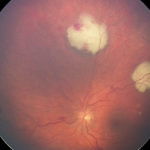
-
Aspergillus keratitis – a case of fungal keratitis following amnoiotic membrane transplantation (AMT) for bullous keratopathy. Slit-lamp photograph of left eye showing ring shaped stromal infiltrate.
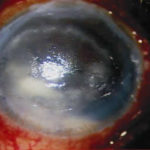
-
A 14 year old boy with a T cell lymphoma received induction chemotherapy with high dose dexamethasone. At no time during this therapy was he neutropenic. Three weeks into treatment his dexamethasone was reduced and stopped due to gastro-intestinal side effects. On recovery of his abdominal symptoms, he developed sudden onset of severe right sided pleuritic chest pain. Initially, he was thought to have a pulmonary embolism as a chest X-ray showed a solid wedge shaped area of consolidation. He then developed a cough and temperature and sputum grew Aspergillus fumigatus. The wedge shaped lesion developed cavitation. Despite AmBisome at 5mg/Kg, commenced within 4 days of onset of symptoms, the chest X-ray appearance got gradually worse over the following week. This led to substitution of Ambisome by caspofungin and voriconazole. He developed a thyroid cyst with haemorrhage that on aspiration grew A. fumigatus. His chest X-ray continued to worsen. He underwent a right lower lobe lobectomy, which confirmed the diagnosis of invasive pulmonary aspergillosis. Unfortunately the thyroid cyst continued to increase in size resulting in removal of the right lobe of the thyroid.
Chest CT scan carried out 3 weeks after lobectomy revealed new lesions within the right upper lobe of the lung. At this time the voriconazole therapy was stopped and posaconazole started. The area of the thyroid remains free of Aspergillus and the lung lesions appear to be improving 6 weeks after the start of posaconazole.
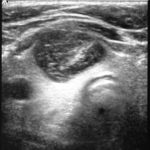 ,
,  ,
, 
-
Aspergillus keratitis. Severe peripheral lesion due to aspergillus unlikely to respond well to treatment.

-
Aspergillus keratitis. Corneal scar at end of treatment of case in previous slide.Vision recovered to 6/9.

-
Aspergillus keratitis. Severe central aspergillus infection with a “cheesey†looking area of the lesion and hypopyon (fluid level of inflammatory cells in the anterior chamber)

-
Corneal ulcer – gram stain. Corneal scrapings were taken from a 67 yr old farmer presenting with a corneal ulcer of the right eye. A piece of vegetable matter was embedded in the cornea and scrapings were done. Gram stain (500x magnification) showed numerous septate hyphae. Cultures grew a small amount of A fumigatus.
